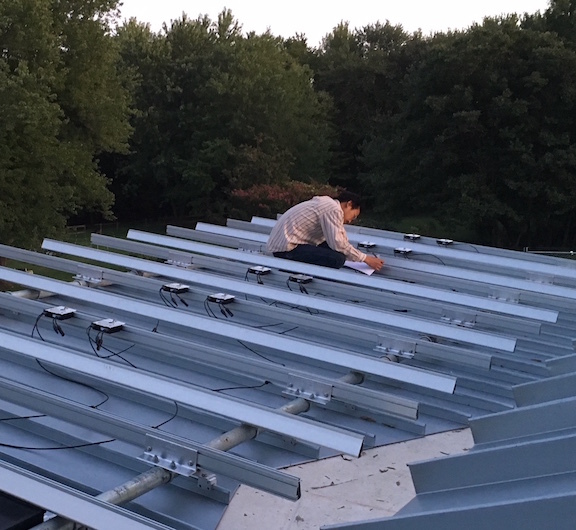 Alan Uy, a PhD student in our research group, passed the ChBE Department Research Aptitude Exam (RAE) this week, clearing the way for Alan to focus on his thesis research. Alan received his BS and MS in ChE from Maryland; his MS thesis research Systems Engineering-Based Model Development: Application to Predictive Simulation of a Net-zero Home was vital to the success of our 2017 Solar Decathlon house automation system, work that is currently being continued by new MSSE student Akanksha Bhat. Alan’s current PhD research is supported by the NASA Goddard Space Flight Center and combines modeling and reactor development work for Atomic Layer Deposition of thin films for optical telescope applications.
Alan Uy, a PhD student in our research group, passed the ChBE Department Research Aptitude Exam (RAE) this week, clearing the way for Alan to focus on his thesis research. Alan received his BS and MS in ChE from Maryland; his MS thesis research Systems Engineering-Based Model Development: Application to Predictive Simulation of a Net-zero Home was vital to the success of our 2017 Solar Decathlon house automation system, work that is currently being continued by new MSSE student Akanksha Bhat. Alan’s current PhD research is supported by the NASA Goddard Space Flight Center and combines modeling and reactor development work for Atomic Layer Deposition of thin films for optical telescope applications.
Category Archives: Uncategorized
New year, reactor, and material system
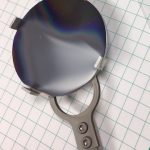
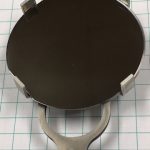 During the first days of 2018, we have been working on a new Atomic Layer Deposition (ALD) reactor system as well as an entirely new material system for our group: tin (IV) oxide (SnO2). Given the novelty of both the reactor and the precursors (ozone and tetrakis(ethylamino) tin), it is not surprising that the first film produced by the reactor showed evidence of gas-phase particle production and high spatial non uniformity (see the left image).
During the first days of 2018, we have been working on a new Atomic Layer Deposition (ALD) reactor system as well as an entirely new material system for our group: tin (IV) oxide (SnO2). Given the novelty of both the reactor and the precursors (ozone and tetrakis(ethylamino) tin), it is not surprising that the first film produced by the reactor showed evidence of gas-phase particle production and high spatial non uniformity (see the left image).
The production of tin oxide particles was key to tracking down the source of our problems – insufficient purge time, as measured by our reactor pressure sensor, resulted in some residual precursor in the reactor chamber after each purge period, leading to gas-phase nucleation and particle growth in the reactor. After doubling the post-Sn and tripling the post-O3 purge periods, a visually uniform and particle-free film was produced (right image).
This work is part of a collaboration with Dr. Vivek Dwivedi of the NASA GSFC, is supported by NASA, and represents part of the PhD thesis research of Hossein Salami and Alan Uy.
SD 2017
 Since January of 2016, nearly everyone in our research group has participated as a member of Team Maryland for the 2017 Solar Decathlon, a biennial competition sponsored by the US DoE in which student teams design and build solar-powered homes.
Since January of 2016, nearly everyone in our research group has participated as a member of Team Maryland for the 2017 Solar Decathlon, a biennial competition sponsored by the US DoE in which student teams design and build solar-powered homes.
In addition to helping design and construct the electrical, mechanical, and other house engineering subsystems, our group was responsible for developing a highly detailed, physically based house dynamic simulator and most of the home automation systems. Virtual reACT runs every morning and predicts the house states over the day based on local weather forecasts. This ability to forecast future energy needs and generating capability was crucial to the success of our house achieving nearly perfect net-zero electrical power performance during the October Decathlon competition period in Denver, where Team Maryland took second place overall and first in US teams.
Hossein advances to candidacy
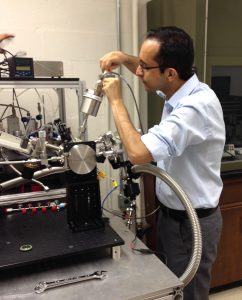 This has been a busy semester of thesis and thesis proposal defenses in our group. Most recently, Hossein Salami defended his PhD thesis proposal A mechanistic framework for reaction network analysis of atomic layer deposition processes with application to titania thin-film manufacturing. While shown here working on our new, NASA-sponsored ALD reactor system, Hossein’s work primarily focuses on the theoretical and computational aspects of using invariants (the linear combinations of deposition reaction species that are constant with respect to time) of reaction networks (RN) to determine whether a well-posed and “proper” simulation can be created using that RN. This approach is crucial to the successful formulation of ALD and CVD simulators that incorporate reaction mechanisms and kinetics data from studies that typically focus only on one fragment of the overall deposition process. More information can be found in the two papers Hossein has authored. This research is sponsored by the CBET division of the National Science Foundation.
This has been a busy semester of thesis and thesis proposal defenses in our group. Most recently, Hossein Salami defended his PhD thesis proposal A mechanistic framework for reaction network analysis of atomic layer deposition processes with application to titania thin-film manufacturing. While shown here working on our new, NASA-sponsored ALD reactor system, Hossein’s work primarily focuses on the theoretical and computational aspects of using invariants (the linear combinations of deposition reaction species that are constant with respect to time) of reaction networks (RN) to determine whether a well-posed and “proper” simulation can be created using that RN. This approach is crucial to the successful formulation of ALD and CVD simulators that incorporate reaction mechanisms and kinetics data from studies that typically focus only on one fragment of the overall deposition process. More information can be found in the two papers Hossein has authored. This research is sponsored by the CBET division of the National Science Foundation.
Two new MS graduates from the group
At the end of the spring 2017 semester, Harika Vakkantula and Alan Uy both successfully defended their Chemical Engineering MS theses. Harika’s thesis Modeling of Thin Films for Self-Cleaning Purposes examined the surface reaction mechanisms responsible for the transition of ALD TiO2 films from superhydrophobic to superhydrophilic under exposure to UV radiation. Her experimental work confirmed this transition for ALD TiO2 deposited using a TDMAT/water precursor system.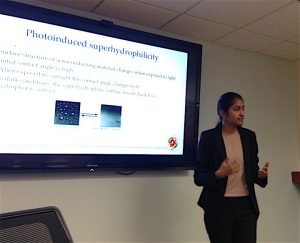 Alan’s thesis Systems Engineering-Based Model Development: Application to Predictive Simulation of a Net-Zero Home describes his work in creating a numerical simulator that predicts the performance of Team Maryland’s reACT Solar Decathlon house as a function of local weather forecasts and anticipated homeowner energy demands. The model forms the basis of Virtual reACT.
Alan’s thesis Systems Engineering-Based Model Development: Application to Predictive Simulation of a Net-Zero Home describes his work in creating a numerical simulator that predicts the performance of Team Maryland’s reACT Solar Decathlon house as a function of local weather forecasts and anticipated homeowner energy demands. The model forms the basis of Virtual reACT.
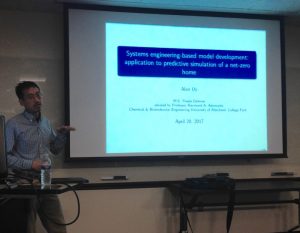 6 December 2017 update: In yesterday’s CHBE department graduate seminar series, the seminar speaker spoke on the design of superomniphobic surfaces. Some of his work on TiO2 surfaces had interesting parallels with Harika’s thesis research – in particular, how the UV radiation-induced hydrophobicity changes can be exploited for sorting and sensing of liquid drops.
6 December 2017 update: In yesterday’s CHBE department graduate seminar series, the seminar speaker spoke on the design of superomniphobic surfaces. Some of his work on TiO2 surfaces had interesting parallels with Harika’s thesis research – in particular, how the UV radiation-induced hydrophobicity changes can be exploited for sorting and sensing of liquid drops.
Hossein receives award at G.R.A.D. 2017
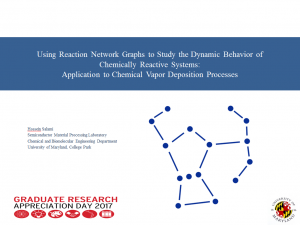 Hossein Salami, a ChE Ph.D. student in our group, won first place for his presentation “Using reaction network graphs to study the dynamic behavior of chemically reactive systems: Application to chemical vapor deposition processes” at the 2017 Graduate Research Appreciation Day here at the University of Maryland. Hossein’s talk was part of the Energy and Technology session of the event and the 1st place award comes with a $500 travel grant. Hossein’s work focuses of chemical reaction network analysis for ALD and CVD processes and is supported by the the CBET division of the National Science Foundation.
Hossein Salami, a ChE Ph.D. student in our group, won first place for his presentation “Using reaction network graphs to study the dynamic behavior of chemically reactive systems: Application to chemical vapor deposition processes” at the 2017 Graduate Research Appreciation Day here at the University of Maryland. Hossein’s talk was part of the Energy and Technology session of the event and the 1st place award comes with a $500 travel grant. Hossein’s work focuses of chemical reaction network analysis for ALD and CVD processes and is supported by the the CBET division of the National Science Foundation.
Self-cleaning surfaces
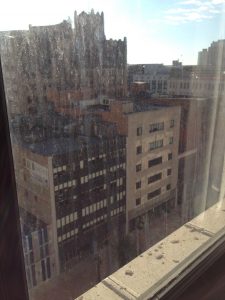 A new area that our research group is exploring has to do with solar-powered, self-cleaning surfaces, such as the external windows of a building. It has been known for some time that semiconductor coatings can be used for photo-catalyzed reactions that are effective in oxidizing organic compounds, thus making the surface self-cleaning. Likewise, some of these semiconductor surfaces have more recently been found to transition from hydrophobic to hydrophilic in the presence of UV light, allowing rainwater to more effectively clean the surface. In our group, MS ChBE student Harika Vakkantula has been studying the surface reconstruction mechanisms of TiO2 films deposited by atomic layer deposition (ALD). She has been using a combination of reaction path analysis to understand the chemical mechanisms at work in the hydrophobic/hydrophilic transition and has been assessing the effectiveness of different ALD processes at producing films that demonstrate this transition.
A new area that our research group is exploring has to do with solar-powered, self-cleaning surfaces, such as the external windows of a building. It has been known for some time that semiconductor coatings can be used for photo-catalyzed reactions that are effective in oxidizing organic compounds, thus making the surface self-cleaning. Likewise, some of these semiconductor surfaces have more recently been found to transition from hydrophobic to hydrophilic in the presence of UV light, allowing rainwater to more effectively clean the surface. In our group, MS ChBE student Harika Vakkantula has been studying the surface reconstruction mechanisms of TiO2 films deposited by atomic layer deposition (ALD). She has been using a combination of reaction path analysis to understand the chemical mechanisms at work in the hydrophobic/hydrophilic transition and has been assessing the effectiveness of different ALD processes at producing films that demonstrate this transition.
PhD proposal defense by Aisha
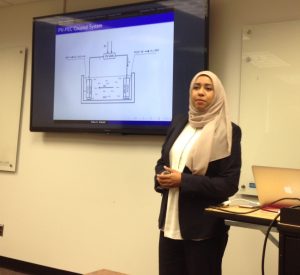 On February 2, Aisha Alobaid defended her PhD thesis proposal on the topic of conversion of solar energy to storable hydrogen and oxygen. At first glance, this seems to be a research area outside of the scope of work normally done by our group, but in reality it is not: thin-film solar-active materials are used for the water splitting process and reaction graph analysis of the aqueous-solution reactions that take place in this system put it squarely into the domain of what we do. Aisha is pursuing both experimental and computational approaches to designing these processes and anticipates graduating with her PhD in 2018.
On February 2, Aisha Alobaid defended her PhD thesis proposal on the topic of conversion of solar energy to storable hydrogen and oxygen. At first glance, this seems to be a research area outside of the scope of work normally done by our group, but in reality it is not: thin-film solar-active materials are used for the water splitting process and reaction graph analysis of the aqueous-solution reactions that take place in this system put it squarely into the domain of what we do. Aisha is pursuing both experimental and computational approaches to designing these processes and anticipates graduating with her PhD in 2018.
Alumni updates
This year ends with good news regarding three of our research group’s recent alumni. First, David Arana-Chavez (PhD 2015) has taken an Assistant Professor position at the Upper Technological Institute of Abasolo, a relatively new university in Guanajuato, Mexico. He is working in the Department of Renewable Energy Engineering, which focuses on biofuel and PV technologies. David has been teaching linear algebra, material and energy balances, and other engineering courses and is working on establishing his research program. Second, Krishnaprasath (KP) Ramakrishnan (MS 2016) has recently accepted a position in the San Francisco Bay area with Vibrant Genomics, a company developing semiconductor-based tools for genomic analysis and the biomedical applications. David and KP both worked in the area of reaction network analysis and are now finding completely new application areas for their research. Finally, Pranay Gupta (ME 2016) has recently taken a solar-energy related position as a Field Performance Engineer for Sunpreme, also located in the Bay area. Congratulations to KP, David, and Pranay on their well-deserved success.
KP’s MS defense
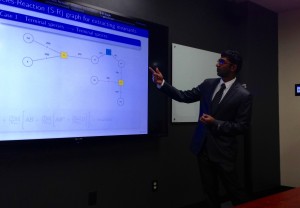 Earlier today, KP (Krishnaprasath Ramakrishnasubramanian) defended his Chemical Engineering MS thesis Reaction Network Analysis for Thin-Film Deposition Processes. This marks the first time anyone in the group presented a thesis in which a species-reaction graph approach was used to understand the physical meaning of reaction invariants. He also presented a first look at the relationship between invariants between ALD and CVD processes.
Earlier today, KP (Krishnaprasath Ramakrishnasubramanian) defended his Chemical Engineering MS thesis Reaction Network Analysis for Thin-Film Deposition Processes. This marks the first time anyone in the group presented a thesis in which a species-reaction graph approach was used to understand the physical meaning of reaction invariants. He also presented a first look at the relationship between invariants between ALD and CVD processes.
